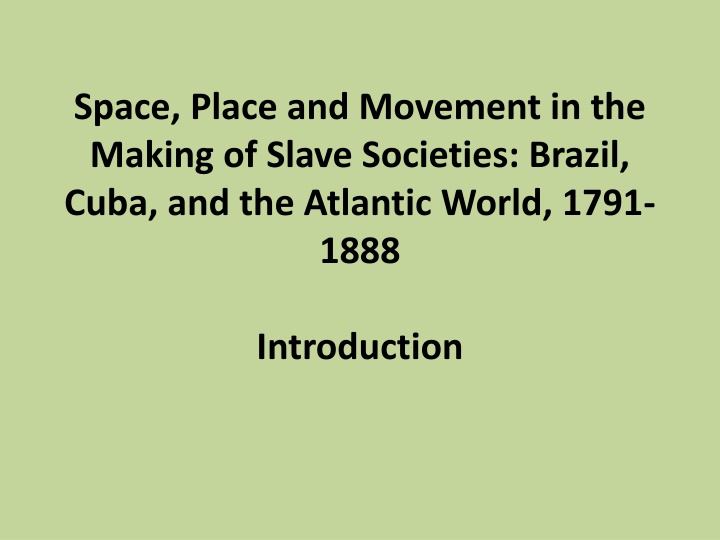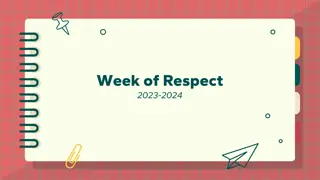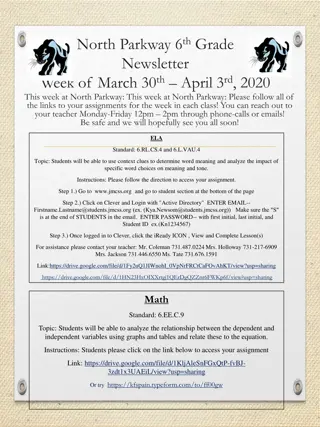
Understanding Space, Place, and Movement in Slave Societies of Brazil and Cuba, 1791-1888
Explore the historical significance of space, place, and movement in the formation of slave societies in Brazil and Cuba within the broader context of the Atlantic World. Delve into the transatlantic slave trade, cultural perspectives, and the dynamics of power, memory, and human interactions. Reflect on the terminology of "enslaved" versus "slaves" and the social construct of race in Latin American societies.
Download Presentation

Please find below an Image/Link to download the presentation.
The content on the website is provided AS IS for your information and personal use only. It may not be sold, licensed, or shared on other websites without obtaining consent from the author. If you encounter any issues during the download, it is possible that the publisher has removed the file from their server.
You are allowed to download the files provided on this website for personal or commercial use, subject to the condition that they are used lawfully. All files are the property of their respective owners.
The content on the website is provided AS IS for your information and personal use only. It may not be sold, licensed, or shared on other websites without obtaining consent from the author.
E N D
Presentation Transcript
Space, Place and Movement in the Making of Slave Societies: Brazil, Cuba, and the Atlantic World, 1791- 1888 Introduction
The course overall The making, and decline, of two nineteenth- century slave societies: Brazil and Cuba Simultaneous apotheosis and vulnerability of C19 slavery (Schmidt-Nowara) Comparative history but also Atlantic World history. Connections of trade, ideas, and especially FLOWS OF PEOPLE So we also cover: Britain; other Caribbean islands (esp St Domingue/ Haiti); US South; West Africa; West Central Africa
The Atlantic slave trade in numbers (1500-1900) 10.8M Africans shipped across Atlantic over whole period of slave trading Brazil and the Caribbean as a whole together received 80% of all slaves traded to Americas The US received only 4% Brazil and Cuba were responsible for most of the trade after 1807: over 2M to Brazil in the C19; over 700,000 to Cuba
Beyond the numbers: other approaches to the study of human movement We ll also cover the trade from other social, cultural perspectives Atlantic world are formed by links of culture, memory as well as by commodities production Insights of the spatial turn in the humanities: analyse spaces and places as well as time Space: a physical pre-existing entity Place: social, a product of human interactions & power dynamics and by a FLOW of people through spaces over time
Slaves or enslaved? Many historians today use enslaved people not slaves some/ all of the time Recognises that no-one is born a slave; slaves are made A political position, but so is slave From 1820/ 1826, trade is ILLEGAL. Most people living as slaves in Brazil/ Cuba are arguably ILLEGALLY enslaved. Some scholars use enslaved when discussing personhood and subjecthood and slave when discussing slaveholders perspective
Race or race? Biologically speaking, race does not exist. Many historians choose to put race in quotation marks in their writing. However, race has a very significant history as a SOCIAL CONSTRUCT. Latin American societies were no less racist, but allowed more racial mixing (miscegenation) and recognised intermediate social/ racial categories e.g. pardo, mulato. In practice, these categories have important social significances BUT: consider HOW they are CONSTRUCTED & vary across time & place: race-making See PBS website: Race: The Power of an Illusion
Questions What were the similarities and differences between the kinds of slave regimes established across the Americas? How did they vary across place and time? Is there one definition of slavery or are there many? What role did slavery play in the national histories of Brazil and Cuba in the nineteenth century and before? Was the nineteenth century an era of abolition, or of an intensification of slavery and the trade?






















